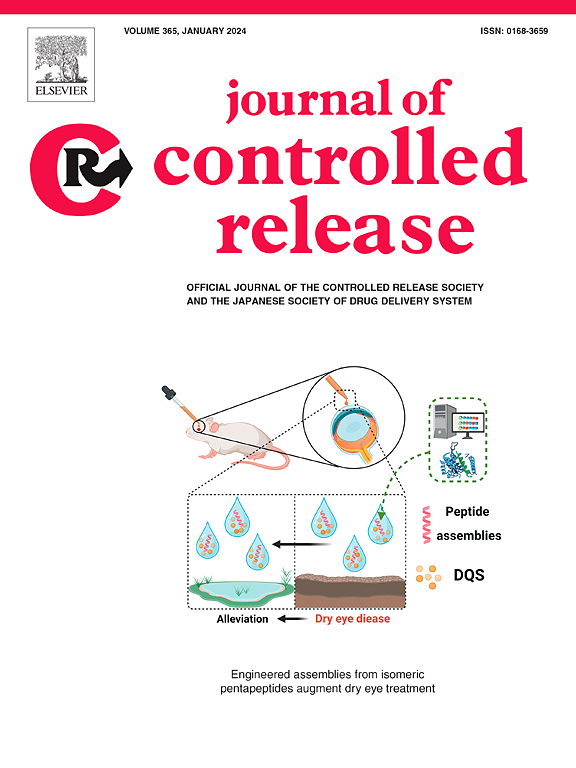脂质纳米颗粒靶向中性粒细胞,减少sars - cov -2诱导的肺损伤和炎症
IF 10.5
1区 医学
Q1 CHEMISTRY, MULTIDISCIPLINARY
引用次数: 0
摘要
迫切需要了解导致COVID-19患者肺部炎症和纤维化的关键因素,从而制定有效的预防策略。过度的中性粒细胞激活,包括细胞外陷阱(NET)的形成,与严重的COVID-19和长期后遗症有关。然而,由于生物利用度短和缺乏细胞类型特异性,中性粒细胞靶向治疗的临床应用具有挑战性。本研究提出了一种脂质纳米颗粒(LNP)平台,旨在将两种已建立的NET抑制剂,DNase I和Sivelestat (Siv),称为DPNLNPs,专门用于肺中性粒细胞。体外和体内实验表明,DPNLNPs优先在肺中性粒细胞中积累,并与游离dna酶I和Siv一样有效地降解NETs。此外,在K18-hACE2小鼠中给予DPNLNPs,以远低于游离药物的剂量显著抑制sars - cov -2诱导的NETs,并与减少肺部和全身炎症、肺上皮损伤和胶原沉积相关。重要的是,仅在感染症状期治疗DPNLNP可改善SARS-CoV-2结局,揭示NETs在COVID-19发病机制中的复杂作用。总之,这项研究作为一种概念验证,可以调整LNP平台,以细胞特异性的方式提供一种以上的免疫调节药物,以管理COVID-19和其他呼吸系统疾病中的net相关并发症。本文章由计算机程序翻译,如有差异,请以英文原文为准。


Lipid nanoparticles target neutrophils to reduce SARS-CoV-2-induced lung injury and inflammation
The need to understand key players driving pulmonary inflammation and fibrosis in COVID-19 patients leading to effective preventive strategies is imminent. Excessive neutrophil activation, including extracellular trap (NET) formation, is associated with severe COVID-19 and long-term sequelae. However, the clinical applications of neutrophil-targeting therapies are challenging due to short bioavailability and lack of cell-type specificity. This study presents a lipid nanoparticle (LNP) platform designed to deliver two established NET inhibitors, DNase I and Sivelestat (Siv) referred to as DPNLNPs, specifically to lung neutrophils. In vitro and in vivo experiments demonstrate that DPNLNPs preferentially accumulate in the lung neutrophils and degrade NETs as efficiently as the free DNase I and Siv. Additionally, administration of DPNLNPs in K18-hACE2 mice significantly inhibited SARS-CoV-2-induced NETs at a much lower dose than the free drugs and correlated with reduced lung and systemic inflammation, lung epithelium injury, and collagen deposition. Importantly, DPNLNP treatment only during the symptomatic phase of infection improved SARS-CoV-2 outcome revealing the complex role of NETs in COVID-19 pathogenesis. Together, this study serves as a proof-of-concept for adapting the LNP platform to deliver more than one immunomodulatory drug in a cell-specific manner to manage NET-associated complications in COVID-19 and other respiratory diseases.
求助全文
通过发布文献求助,成功后即可免费获取论文全文。
去求助
来源期刊

Journal of Controlled Release
医学-化学综合
CiteScore
18.50
自引率
5.60%
发文量
700
审稿时长
39 days
期刊介绍:
The Journal of Controlled Release (JCR) proudly serves as the Official Journal of the Controlled Release Society and the Japan Society of Drug Delivery System.
Dedicated to the broad field of delivery science and technology, JCR publishes high-quality research articles covering drug delivery systems and all facets of formulations. This includes the physicochemical and biological properties of drugs, design and characterization of dosage forms, release mechanisms, in vivo testing, and formulation research and development across pharmaceutical, diagnostic, agricultural, environmental, cosmetic, and food industries.
Priority is given to manuscripts that contribute to the fundamental understanding of principles or demonstrate the advantages of novel technologies in terms of safety and efficacy over current clinical standards. JCR strives to be a leading platform for advancements in delivery science and technology.
 求助内容:
求助内容: 应助结果提醒方式:
应助结果提醒方式:


